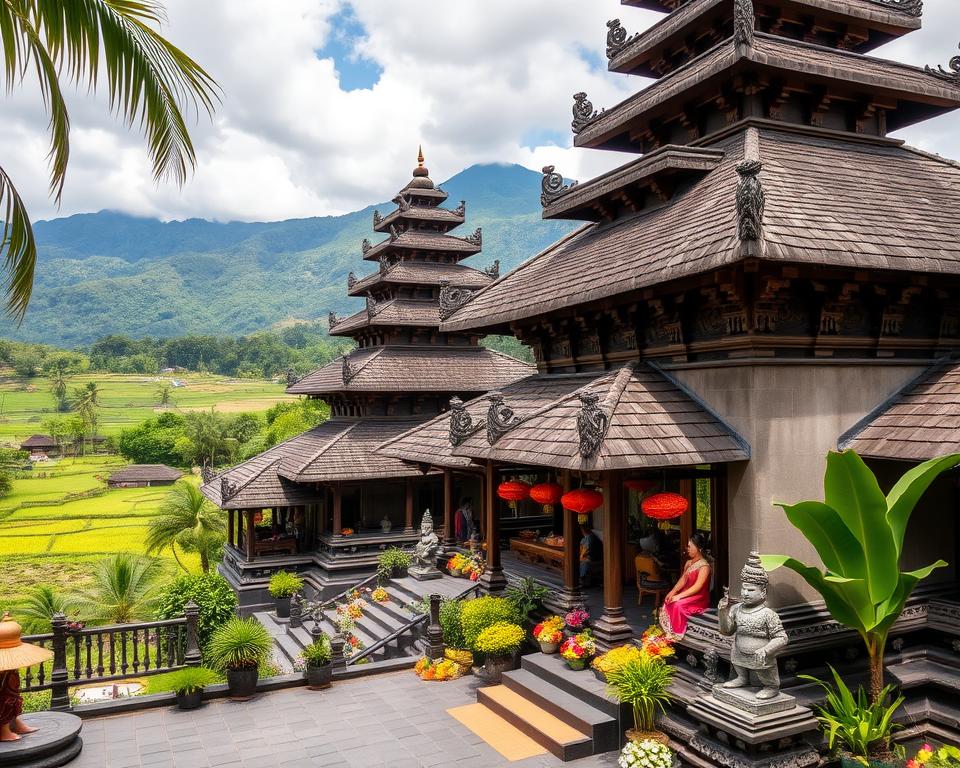
Architectural Styles of Ubud Temples
Bali is famous for its beautiful landscapes and lively culture. It’s full of architectural wonders that show the island’s history and spiritual depth1. Traditional Balinese buildings, with their detailed designs and carvings, blend well with nature. You can see these in temples, palaces, and historic sites all over the island2.
Balinese architecture comes from the island’s way of life, social structure, and beliefs. It’s greatly influenced by Balinese Hinduism.
Key Takeaways
- Balinese architecture is deeply rooted in the island’s rich cultural heritage and spiritual traditions.
- Traditional Balinese buildings are designed to harmonise with the natural environment, using organic materials like thatch, bamboo, and stone.
- Balinese temples, or pura, are open-air places of worship within enclosed walls, following the Tri Mandala concept for space allocation.
- Balinese architecture is influenced by a range of architectural styles, from Classical Hindu and Buddhist to more modern Dutch and Japanese influences.
- Balinese architects, known as Undagi, are highly skilled in both technical and philosophical aspects of design, ensuring harmony between the built environment and the natural world.
Balinese Temple Architecture: A Harmonious Blend of Spirituality and Artistry
Exploring Balinese temple architecture is like a journey into the heart of the island3. It shows the deep culture and spirituality of this place3. The temples have beautiful carvings and sacred areas, showing the Balinese values3.
Many temples in Denpasar have visitor centers. They give info on the temple’s history and design3. Going to local ceremonies lets you see how the architecture helps with spiritual and community activities.
Tri Hita Karana: Balancing Harmony with Nature and the Divine
At the core of Balinese temple design is Tri Hita Karana. It talks about balance between humans, nature, and gods3. The temples blend open spaces and nature with sacred structures, making a peaceful place.
Tri Mandala: The Sacred Zoning of Temple Compounds
The Balinese spatial organization, Tri Mandala, adds to the temples’ spiritual and architectural value3. It divides the temple into three parts: outer, middle, and inner realms3. This zoning makes sure the temple’s design focuses on harmony between the physical, natural, and divine.
3 Some temples in Bali offer cultural workshops. You can learn traditional arts like wood carving or painting3. Denpasar is easy to get around with taxis, private drivers, and scooter rentals3. Guided tours include transport and teach about the temples’ architecture and history.
3 Many temples ask visitors to wear sarongs or sashes, which are available for rent3. Exploring Balinese temple architecture is a rich experience. It combines beautiful sights with spiritual depth, letting visitors dive into the mix of spirituality and art.
Architectural Styles of Ubud Temples
Ubud is the cultural heart of Bali. It has many temples showing the island’s rich history4. These temples, called pura, are open-air places of worship with decorated gates4.
The design of these temples follows the Tri Mandala concept. This means they have three zones: Nista Mandala, Madya Mandala, and Utama Mandala4.
Ubud’s temples show the region’s spiritual traditions. They mix Balinese, Hindu, and Buddhist styles5. You’ll see thatched roofs and hand-carved designs5.
These temples have unique statues and detailed carvings4. Pura Dalem has statues of death, while Pura Taman Saraswati has amazing door details4.
Ubud’s temples are not just sacred spaces. They are also cultural hubs4. The Puri Saren Agung has beautiful carvings from the 1800s4.
The Gunung Lebah Temple offers peaceful views over the Cerik River4. Goa Gajah, or the Elephant Cave, is famous for its entrance4.
Ubud’s temples show the island’s rich culture and the Balinese people’s skill6. They mix old and new styles, creating a beautiful experience for visitors6.
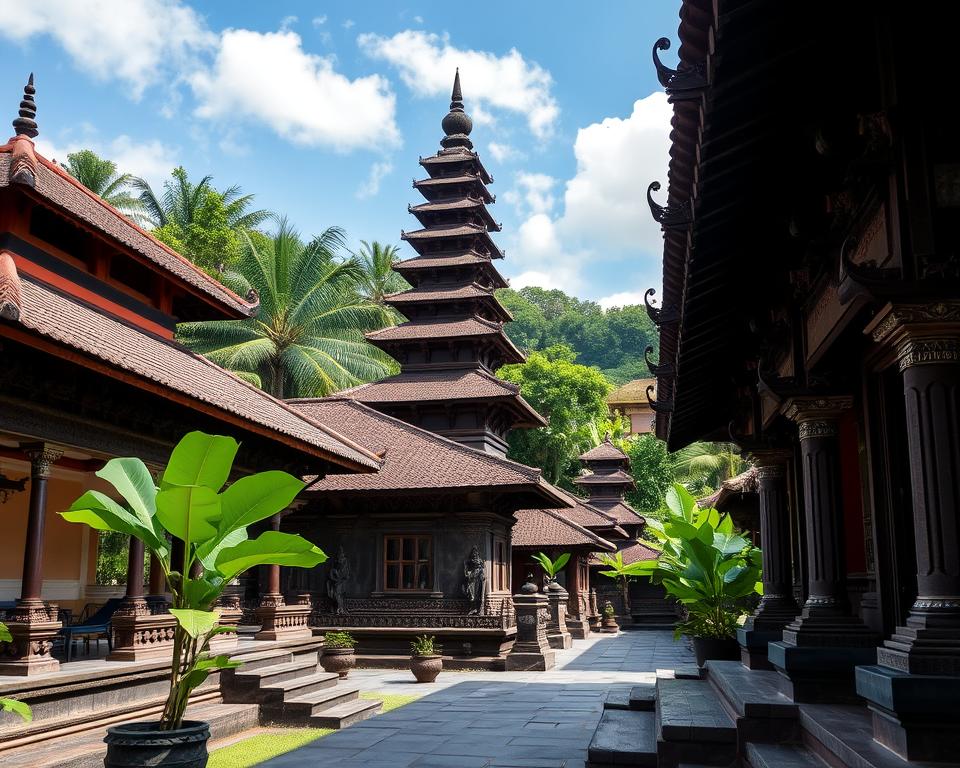
| Temple Name | Architectural Highlights | Visitor Information |
|---|---|---|
| Pura Taman Saraswati | Impressive door details and intricately designed architecture | No entrance fee, but a fee of 80,000 IDR for a traditional Balinese dance performance |
| Pura Dalem | Bizarre and unique statues dedicated to the spirit of death | Located just outside Ubud |
| Ubud Sacred Monkey Forest | Pura Dalem Agung Padangtegal built in the 14th century | A popular destination filled with wild monkeys, can be quite busy during peak times |
| Puri Saren Agung (Ubud Palace) | Intricate stone carvings and artwork from the 1800s | Designed for the royal family of Ubud |
| Gunung Lebah Temple | Serene views over the Cerik River | A more secluded experience, away from typical tourist crowds |
| Goa Gajah (Elephant Cave) | Entryway carved in the shape of a monster’s mouth | A renowned spot in Ubud that draws significant crowds |
| Samuan Tiga Temple | Intricate stonework dating back to the 10th century AD | Dedicated to the Hindu Trinity, a hidden gem just outside of Ubud |
| Goa Garba Ruins | Opportunity to explore archaeological ruins | Specific statistical data not provided |
Ubud’s temples show the island’s rich culture. They mix old and new styles6. These temples, like Gunung Lebah and Goa Gajah, give a glimpse into Bali’s art and spirituality4.
Pura Taman Saraswati: A Tranquil Oasis of Hindu Architecture
In Ubud, Bali, Pura Taman Saraswati is a beautiful example of Balinese Hindu architecture7. It was built in 1951 and finished in 1952. The famous artist Gusti Nyoman Lempad designed it, believed to have lived 116 years7.
The temple has a special paduraksa, a gateway to the sacred area7. Around it, a calm courtyard hosts kecak performances. These shows tell stories of good vs. evil7.
Two big frangipani trees add to the temple’s peace. Their flowers are used in prayers all over Bali7. It’s a quiet place away from the busy streets of Ubud7.
Intricate Stone Carvings and Lotus Ponds
The temple’s walls are covered in detailed stone carvings7. At its center is a peaceful lotus pond. The pond’s pink flowers make the place magical7.
The temple honors Saraswati, the goddess of learning and arts7. Inside, you can find lontar, palm leaf manuscripts with prayers7. It’s a place where art and spirituality meet, making it a special oasis in Ubud.
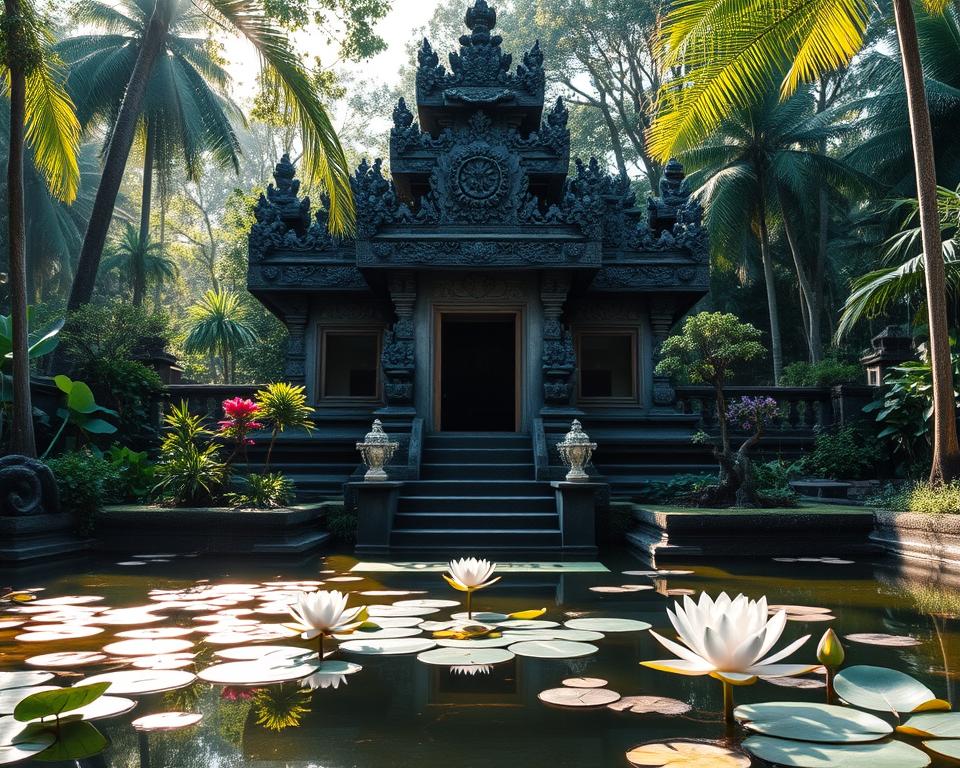
To learn more about Balinese Hindu architecture, visit other temples. See the Lempuyang Temple, Ulun Danu Beratan Temple, or Besakih Temple complex8. These temples show Bali’s rich culture and architecture.
| Temple Name | Unique Architectural Features |
|---|---|
| Taman Saraswati Temple | Intricate stone carvings, lotus pond, dedicated to the goddess Saraswati |
| Lempuyang Temple | Multi-tiered structure with the first level open to visitors |
| Ulun Danu Beratan Temple | Four sacred buildings honoring different gods, Trimurti belief representation |
| Besakih Temple | Six-level complex with 23 temples, largest being Pura Penataran Agung |
| Tanah Lot Temple | Spectacular setting on a cliff overlooking the ocean, historical significance |
| Ling Gwan Kiong | Blend of Balinese and Chinese architectural elements |
Visiting these temples will help you understand the beauty and meaning of Balinese Hindu architecture better.
Goa Gajah: The Mystical Elephant Cave Sanctuary
In Ubud’s greenery, Goa Gajah, or the Elephant Cave, shows the mix of Balinese Hindu-Buddhist Architecture and spiritual influences9. The cave’s entrance looks like an elephant’s head. This hints at its mystical and sacred nature9.
Inside, you’ll see ancient bathing pools and meditation spots. These show the mix of Hindu and Buddhist in Balinese design9. The cave’s design shows Bali’s spiritual side and the builders’ skill9.
The main cave has three stone idols wrapped in colourful cloth. They represent important deities in the fusion of spiritual influences9. The temple’s carvings of mythological figures and deities show the art of that time9.
Goa Gajah dates back to the 9th century, making it a key historical site in Bali9. The sacred pools found in 1954 show the importance of renewal and purification in Hinduism9. Though once on the UNESCO World Heritage Tentative List, it was removed in 2015 to protect it for locals9.
For history lovers, architecture fans, or those seeking peace, Goa Gajah is a must-see. It takes you to the heart of Bali’s spiritual heritage9.
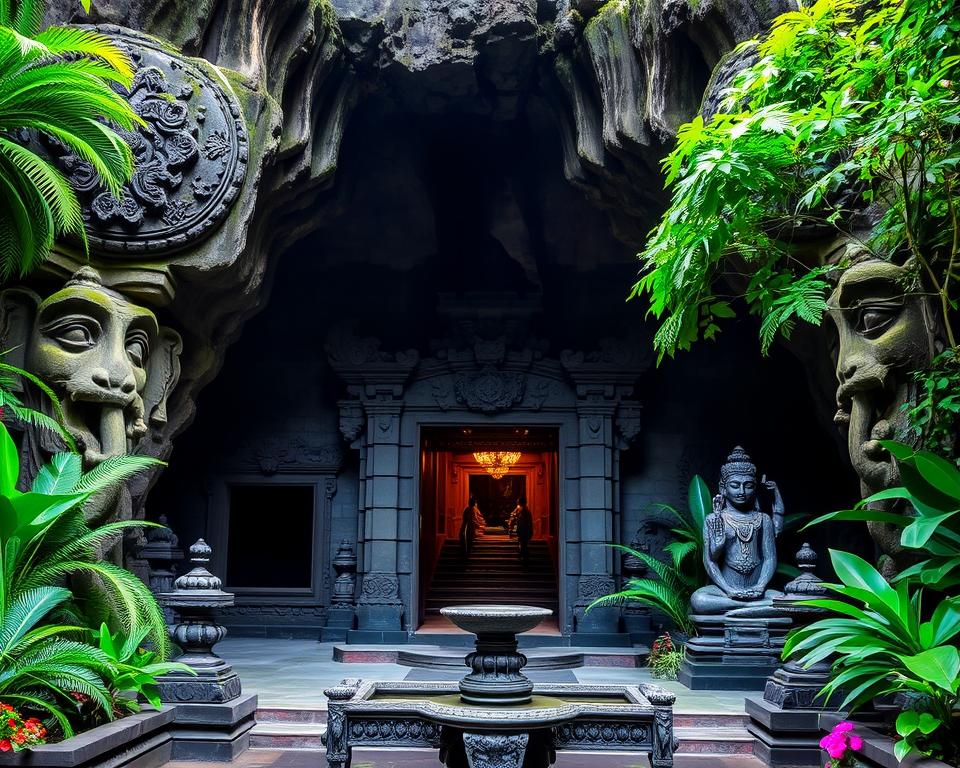
“Goa Gajah is a testament to the ingenuity and spirituality of the Balinese people, where the natural world and the divine coexist in perfect harmony.”
Pura Gunung Kawi: Carved Shrines of the Ancient Kings
In Bali’s Tampaksiring region, Pura Gunung Kawi is a treasure. It has a rich history and beautiful shrines for ancient royalty10. The temple’s design fits perfectly with nature, showing respect for both the divine and the earth10.
The complex has ten amazing candi (shrines) carved into cliffs by the Pakerisan River10. On the other side, four more candi add to the beauty10. Built in the 11th century, they show the skill and faith of the ancient kings10.
The shrines have big roofs with nine symbols of fertility11. A legend says Kebo Iwa, a commander with powers, carved them in one night11.
Visiting Pura Gunung Kawi is a deep experience. You’ll walk down many steps to get there11. The view of rice fields and nature is breathtaking, making it a peaceful place10.
Best time to see Pura Gunung Kawi is from April to October. The weather is nice then12. It’s open from 7:00 AM to 6:00 PM every day12. Early morning or late afternoon visits are quieter12.
Pura Gunung Kawi is a marvel of ancient architecture and culture10. It’s a place to learn about history, see amazing carvings, and feel the Balinese traditions11.
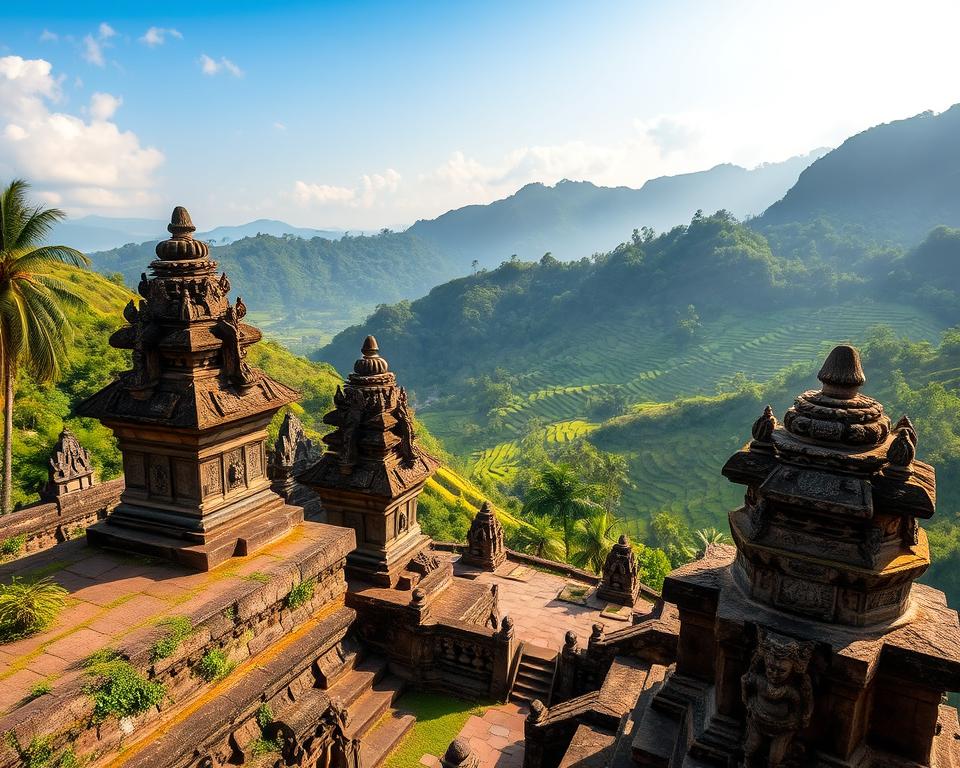
“Pura Gunung Kawi is a true jewel in the crown of Bali’s architectural heritage, where the past and present converge in a symphony of spirituality and natural wonder.”
Pura Penataran Sasih: A Harmonious Fusion of Nature and Architecture
Pura Penataran Sasih is in Ubud, surrounded by greenery. It’s a mix of Balinese architecture and nature13. This old temple is from the 12th century. It shows Bali’s culture with traditional building materials and wooden carvings.
The temple looks like it’s part of the landscape. It has thatch roofing, bamboo and stone parts. This makes a beautiful harmonious Balinese design13. People who visit see amazing artistry and spirituality together.
The temple has ancient bronze drums for rituals13. These drums and the decorations show Bali’s cultural significance. They remind us of Bali’s heritage.
Visiting Pura Penataran Sasih is special. It shows how nature and architecture mix in Balinese culture13. The temple blends with nature and uses traditional building materials. This makes a harmonious and captivating visit.
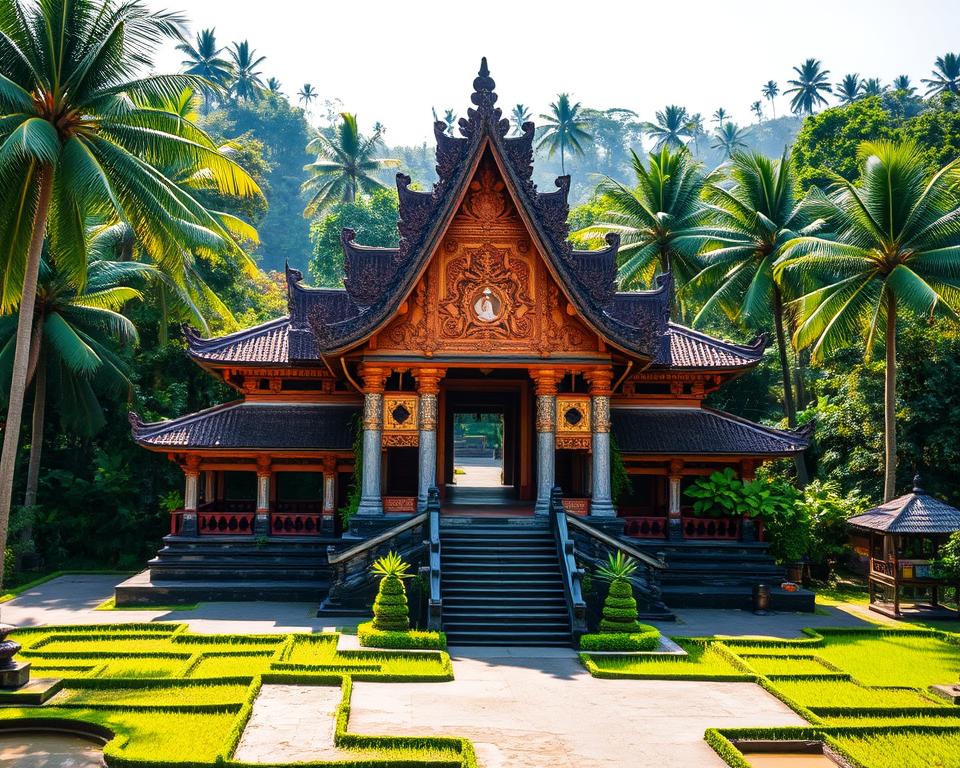
Walking around the temple, you see intricate carvings and feel spiritual energy. Pura Penataran Sasih shows Balinese architecture’s lasting impact. It’s where divine and natural meet in harmony13.
“Pura Penataran Sasih embodies the essence of Balinese design, where the built environment and the natural world come together in a mesmerizing display of artistry and spirituality.”
Tirta Empul: The Purifying Waters of Ubud’s Holy Spring
In the heart of Ubud, Bali, lies the Tirta Empul Temple. It’s a water sanctuary that has drawn visitors for centuries. This temple, from 926 AD14, honors the Hindu god of water, Vishnu. It’s famous for its sacred spring and ritual baths14.
As you enter, the temple’s beauty hits you. It mixes Balinese traditions with nature. The inner courtyard has purification pools. Here, people can bathe in waters believed to cleanse14.
To enter, you’ll need to rent a sarong for IDR 10,00015. You’ll also store your things in a locker for IDR 15,00015. Adults pay IDR 50,000 to enter. Kids 5 to 11 pay IDR 25,000. Kids under 5 get in free15.
The temple is open from 8:00 AM to 6:00 PM daily. It’s open 24/7 for prayer15. Visit early morning or late afternoon to avoid crowds15. Local buses or bemos offer cheap ways to get there15.
Ritual Bathing and Architectural Elegance
Visiting Tirta Empul means taking part in purification rituals. You can bathe in the holy spring’s clear waters. These waters are believed to cleanse body and spirit14.
The temple’s stone carvings and architecture add to its beauty. It’s a mix of nature, spirituality, and art14. A visit to Tirta Empul is a must in Ubud15. It’s a unique experience of beauty and spirituality14.
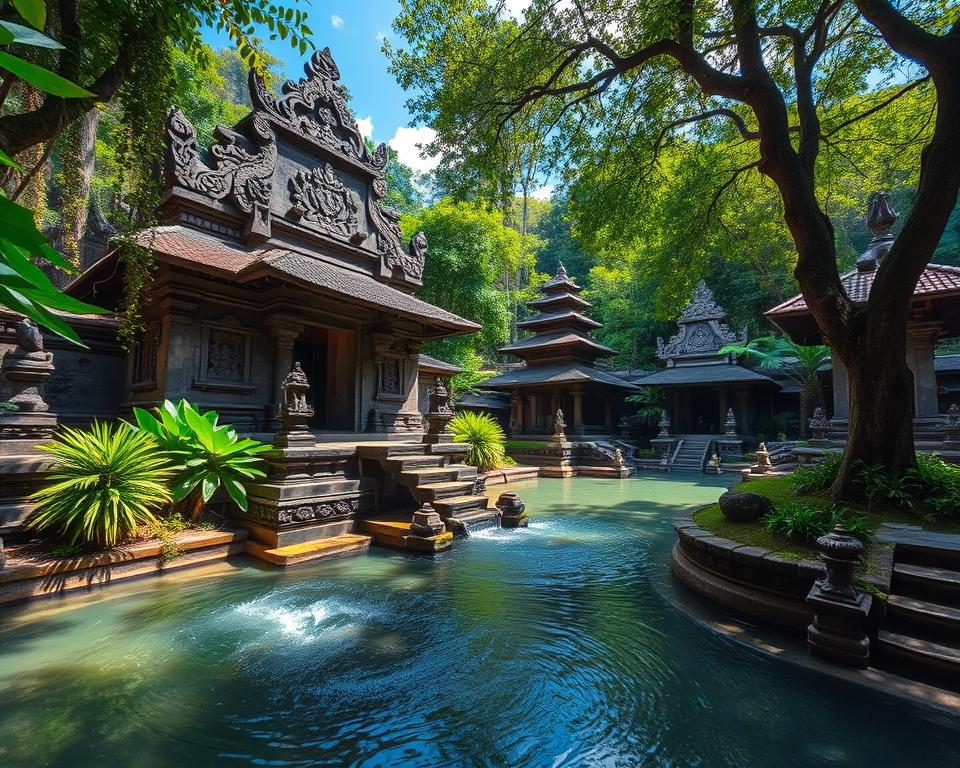
Yeh Pulu: Discovering Ubud’s Hidden Architectural Gem
In the heart of Ubud, Bali’s cultural hub, is Yeh Pulu. It’s a secret treasure with amazing rock carvings and ancient art. It has amazed people for many years16.
Yeh Pulu is carved into a cliff. It shows reliefs and bas-reliefs of daily life and myths. It’s a peek into Bali’s rich culture, showing its artistic past17.
Visiting Yeh Pulu feels like going back in time. Ancient Balinese artists left their mark here. Their carvings, full of details, share stories of the past18.
If you love history, art, or just want to connect with Bali’s culture, Yeh Pulu is a must-see. Explore Ubud’s green landscapes and discover Yeh Pulu’s timeless artistry.
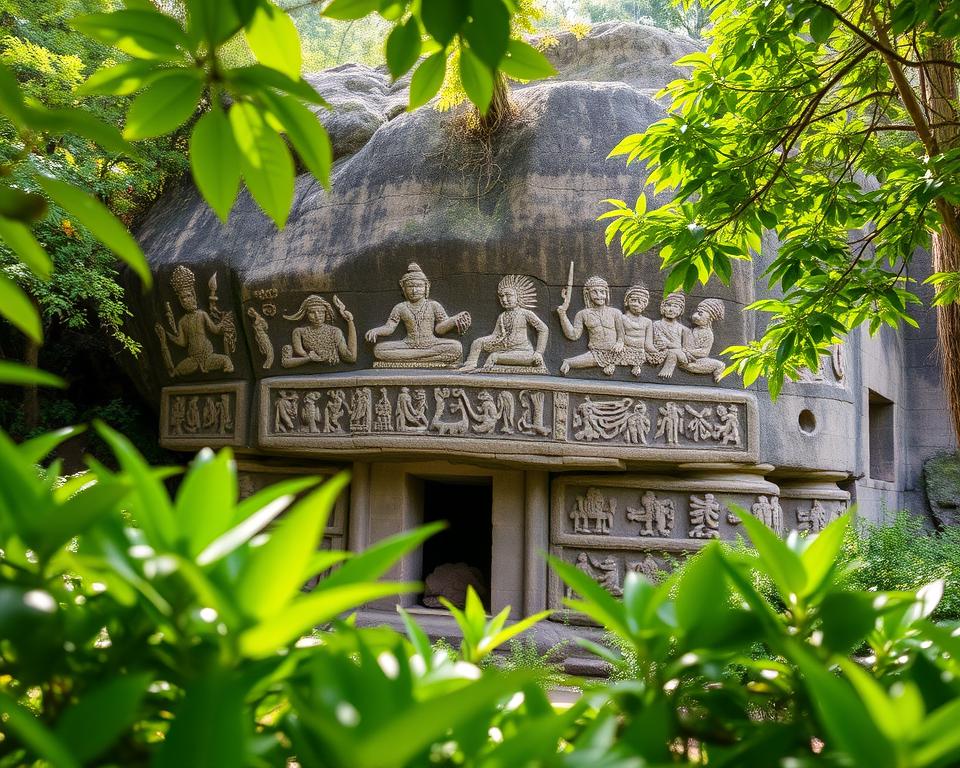
“Yeh Pulu is a hidden treasure that offers a rare glimpse into the rich artistic tapestry of ancient Bali. It’s a must-see for anyone seeking to connect with the island’s cultural heart.”
Artistry in Stone: The Sculptural Wonders of Ubud’s Temples
Ubud is the heart of Bali’s culture. It’s famous for its amazing stone art in temples. The temple carvings show the Balinese people’s deep reverence for the divine.
The Balinese temple architecture in Ubud mixes spirituality and art. It shows the Tri Hita Karana philosophy of harmony with nature and the divine19. The Ubud Royal Palace has beautiful carvings and sculptures. The Saraswati Temple is known for its lotus pond and detailed stone carvings.
Outside central Ubud, the Balinese stone sculptures and temple carvings amaze visitors. The Goa Gajah, or Elephant Cave, has amazing architectural ornamentation. Pura Gunung Kawi and Pura Penataran Sasih show the Balinese artistry.
Exploring Ubud’s Artistic Treasures will amaze you. The sculptural wonders of Ubud’s temples show the Balinese skill in stone carving and architecture2021.
Conclusion
The temples in Ubud show the rich culture and deep beliefs of the Balinese people. Pura Taman Saraswati beautifully mixes nature with design22. Yeh Pulu’s rock carvings tell stories of Bali’s art and building skills23.
Keeping these temples safe lets Bali’s culture live on. It draws visitors from everywhere, showing the magic of Balinese spirit and art.
Ubud’s temples show the lasting impact of Balinese culture2322. Places like Pura Gunung Kawi have amazing stone carvings24. Tirta Empul lets you see purification rituals24.
These sites give a peek into the Balinese way of life. They show how nature, spirit, and art come together.
Visiting Ubud’s temples, you’ll see designs that have lasted for ages2322. Each temple shows the Balinese people’s creativity and strength. By saving these wonders, we help Balinese culture grow and inspire others.
FAQ
What are the key architectural features of Balinese temples?
Balinese temples, or pura, are open-air places of worship. They have walls and gates that are decorated. Inside, you’ll find shrines, towers, and pavilions.
The design follows the Tri Mandala concept. This concept organizes space in a special way.
How does Balinese architecture reflect the island’s spiritual and cultural heritage?
Balinese architecture shows the island’s spiritual and cultural roots. It follows the Tri Hita Karana concept. This concept is about harmony between humans, nature, and the divine.
It also follows the Tri Mandala spatial organization. This shapes the design and construction of temples.
What are some of the most iconic Balinese temples in Ubud?
Ubud is home to famous temples like Pura Taman Saraswati and Goa Gajah. Pura Gunung Kawi, Pura Penataran Sasih, and Tirta Empul are also iconic. Each temple shows the beauty and spiritual importance of Balinese design.
How do the temples in Ubud blend with the natural environment?
Temples like Pura Taman Saraswati and Pura Penataran Sasih blend with nature. They use traditional materials and water elements. This creates a perfect mix of architecture and environment.
What is the significance of the intricately carved stone and sculptural elements in Ubud’s temples?
The stone carvings and sculptures in Ubud’s temples show Balinese artistry. They make the temples beautiful and carry deep spiritual and cultural meaning. These designs are a highlight of Balinese architecture.
Source Links
- https://en.wikipedia.org/wiki/Balinese_architecture
- https://bali.com/bali/travel-guide/culture/balinese-architecture/
- https://purimesarihotel.com/balinese-temple-architecture/
- https://finnsbeachclub.com/guides/best-temples-in-ubud-bali/
- https://www.aesdes.org/2024/01/24/aesthetic-exploration-traditional-balinese-architecture/
- https://designmangrovebay.com/2023/01/19/exploring-the-beautiful-bali-architecture-an-insight-into-traditional-and-modern-balinese-design/
- https://www.thenotsoinnocentsabroad.com/blog/pura-taman-saraswati-the-heart-of-ubud
- https://medium.com/@romeo78.adelaide/paradise-awaits-at-6-balis-must-visit-temples-1bd93e22503b
- https://villaamrita.com/elephant-cave-goa-gajah-ubud/
- https://www.baligoldentour.com/gunung-kawi-temple.php
- https://www.indonesia.travel/au/en/destinations/bali-nusa-tenggara/bali/gunung-kawi-temple.html
- https://balicheapesttours.com/gunung-kawi-temple.html
- https://whatsnewindonesia.com/bali/ultimate-guide/travel/hidden-sanctuaries-best-underrated-pura-temples-bali
- https://ubudartresort.com/article/tirta-empul-temple
- https://www.balicheapesttours.com/tirta-empul-temple.html
- https://www.vilondo.com/where-to-stay-in-bali/ubud-guide/
- https://www.murnis.com/category/pdf-files/
- https://www.davidpublisher.com/Public/uploads/Contribute/5c8f1204c28cb.pdf
- https://balicheapesttours.com/ubud-royal-palace.html
- https://banbanjara.com/best-temples-in-ubud
- https://come2indonesia.com/journey-to-ubud-bali-indonesia/
- https://thingstoseeinubudbali.com/what-are-the-best-must-see-temples-to-visit-in-ubud-bali/
- https://www.ubudvillasrental.com/balinese-temples-6-things-you-must-know/
- https://ubudkayahouse.com/article/tirta-empul-temple